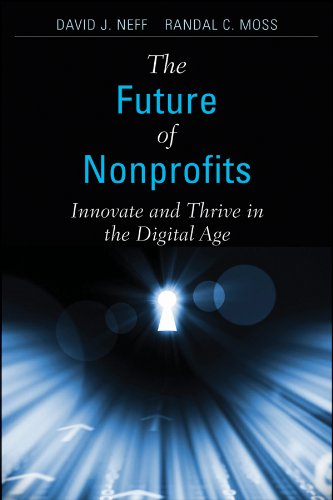Book Review: The Future of Nonprofits
 All great advice books have a certain agelessness. While their subject is defined by their time, they share common themes and ancient wisdom. Placed in a different time and place, they could have been written by Aristotle, Plato, Montaigne, Thoreau or by modern authors Dale Carnegie, Stephen Covey or Jim Collins.
A new addition to the library of timeless advice is Randal Moss and David Neff's The Future of Nonprofits.
All great advice books have a certain agelessness. While their subject is defined by their time, they share common themes and ancient wisdom. Placed in a different time and place, they could have been written by Aristotle, Plato, Montaigne, Thoreau or by modern authors Dale Carnegie, Stephen Covey or Jim Collins.
A new addition to the library of timeless advice is Randal Moss and David Neff's The Future of Nonprofits.
This book examines how the future of innovation, internal entrepreneurship, fundraising and social media communications that will radically change nonprofits in five years. They also provide a blueprint for how nonprofits can change and prosper in such a radically new environment.
Here are several key points from the book:
Change is inevitable. Nonprofits not only need to change, but they need to anticipate what that change will be. This requires a whole different worldview for nonprofits, which are generally conservative and backward. The good news is that being a nonprofit that anticipates change doesn't require a Ghandi-like leader or a Harvard MBA. We all have the ability to reflect on the future and see what's next. But it requires effort and discipline. Nonprofits need a new mindset and better habits, not a fortune teller.
It's within this context that the two authors tee-up social media, one of the biggest change agents of recent memory and the focus of their book.
Bottom-line innovation is key. Innovation is important for every industry, including nonprofits. But it shouldn't be confused with unnovation, a term the authors borrow from Harvard Business Review blogger Umair Haque, to describe innovations that don't really contribute to the bottom line. While such innovations may be useful to the nonprofit, they don't drive success and can actually be harmful as they take your attention away from the things that truly matter. But the authors draw an important line even here. Although you may be able to identify an important, bottom-line innovation for your organization, it is only truly innovative if it can be achieved. Good ideas are one thing. Good ideas that can be executed are a different breed.
I often see this with cause marketing in many organizations. While it can represent a key innovation to may nonprofits and has significant financial rewards, there's no will or drive in the nonprofit to realize its potential and see this innovation achieved. If you think you can, you're right. If you think you can't, you're right too.
Innovation begins with awareness. This section of David and Randal's book could have been summarized by Thoreau: "Only that day dawns to which we are awake." Nonprofits must begin by awakening inside and examining themselves first. How is your organization promoting itself? What channels are you using? What are the results (i. e. real innovation)? Only when you can answer these key questions can you truly understand and address competitors. But most nonprofits are insular and unaware. The authors offer a number of great resources in Chapter 5 to break the bubble in which many nonprofits exist and to encourage competitive collaboration.
The Future of Nonprofits is one of those books that will you make you feel better about the direction your nonprofit is headed because it lays out a map to achieve innovation and sustainable change. Reading it, I never despaired that nonprofit were a in a hopeless situation, nor did I feel overwhelmed that David and Randal were proposing too much too fast. What I did feel was that I was reading something that was true, achievable and applicable to any nonprofit.
So many people have so much advice for nonprofits it's difficult to decide who to listen to. Start with David and Randall as they are looking into a not-so-distant future that you can't afford to miss. You'll conclude as I did that this nonprofit advice book is the best you've read in a long, long time.
